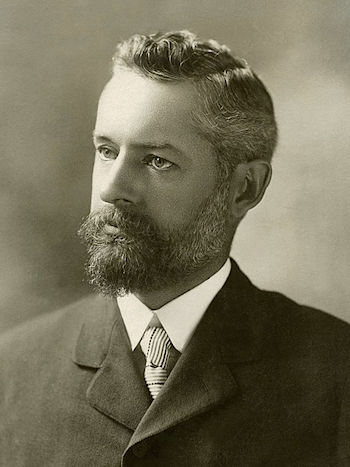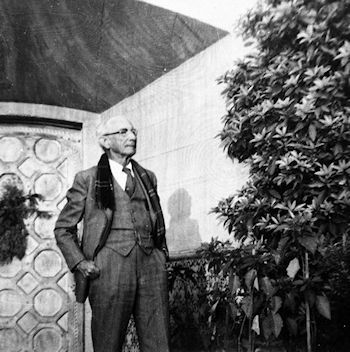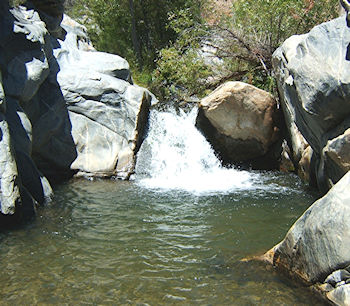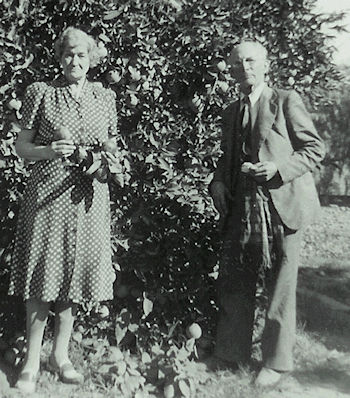 |  |
By Greg Niemann

While the piscatory stars that put the Baja California fishery on the map are saltwater species, there are freshwater fish in Baja. They’re in the Sierra San Pedro Martír and the surviving native trout there can thank a dedicated businessman from Orange County for their continued survival.
Back in 1905 a native species of rainbow trout was discovered in the San Antonio Creek and a few streams of the San Pedro Martír by Edward W. Nelson and was subsequently called the Nelson Rainbow Trout (salmo nelsoni). Nelson was a biologist who later published Lower California And Its Natural Resources for the National Academy of Sciences in Washington D.C.
Later, in 1925, the University of California Museum of Vertebrate Zoology sent an expedition to Baja to study the rare new species.
Expedition member Chester C. Lamb, Assistant Curator of Mammals for the museum, said, “So far as known, only one stream in Lower California is inhabited by trout, namely the Santo Domingo River. This stream heads on the west slope of the San Pedro Martír Mountains, and the trout exist chiefly in one of its branches, San Antonio Creek, and in that branch almost altogether above Rancho San Antonio.
“At the time our fish were collected, it is believed that the species existed in only about five miles of the course of the stream, for the reason that at least 15 miles of the lower course was, at that season, dry. About five miles above Rancho San Antonio are waterfalls above which no trout are known to occur.”
A 1926 University of California Press booklet The Trout of the Sierra San Pedro Martir, Lower California by John Otterbein Snyder detailed the findings of the expedition. Snyder wrote, “The cañon of the river in which these trout live is narrow and deep, and the water, according to Mr. Lamb, at times becomes warm. Insect life, too, is plentiful. The trout were found to be extremely abundant and easily caught. About 150 were taken on two fly hooks, one a brown hackle and the other a royal coachman.”
While the scientists offered pages of measurements and comparisons, in layman’s language they concluded that the new trout is most closely related to the Kern River trout and various species of the golden trout of the Kern River region. The similarities are the position of the dorsal, and the bright tips of the dorsal, anal, and ventral fins.

It is a wonder that the fish survived and proliferated given their limited habitat.
Responsible for resurrecting the Baja fishery was Charles E. Utt, (1866-1950) a self-driving person who was in the habit of making things happen.
Based in Orange County, CA, he owned the Utt Pioneer Store in Tustin. In 1896 he established the Tustin Water Works and later became president of the First National Bank of Tustin. He played a prominent role in establishing the Tustin Union High School District and what became the C.E. Utt Middle School.
In 1906 he leased 1,000 acres from James Irvine and became one of Orange County’s most progressive agriculturists. He was president of the San Joaquin Fruit Company and the Utt Juice Company.
Utt’s interests and enthusiasm knew no bounds. In 1924 he read the “fairly lengthy report of Mr. Nelson” and had to check out Baja’s trout for himself. With a couple of companions he drove down to Hamilton Ranch and secured a guide, Claro Martorel, who lived near the ruins of the Santo Domingo Mission. “At San Antonio,” Utt later wrote, “About 40 miles out by pack train we found trout in the river and in a branch commonly called La Zanja, which enters it at San Antonio.”
After a little trout fishing, they went duck hunting and then bivouacked one day “beside a beautiful babbling brook near the old mission (San Pedro Martir) and mourned the absence of trout where there was such a beautiful home for them.”
Over the next several years Utt was haunted by those several streams barren of trout. His solution: Do it yourself!
“It was in the summer of 1929 that with a companion I went again to San Antonio armed with a quantity of five-gallon cans for transporting the fish. As this was my first experience of the kind I did not know how many fish to put in a can nor how long they would live between changes of water. To be on the safe side I put five fingerlings (taken with ordinary fly hook) in each can....I loaded one mule with fish and another with four cans of water for change as I did not know how long it would be to water or how long the fish would live without change.”

It was a difficult and challenging several days fine-tuning the process, including dumping fish in streams in the middle of the night, before they had stocked fish “both above and below the gorge.”
“I did not again visit the newly stocked stream until 1934 (five years later) at which time I found it teeming with trout. The experiment had been so successful that I determined to extend my fish farms each summer.”
Over the next few summers, when Utt did revisit and restock the streams he usually took family members, including his son-in-law Tomás Robertson. He often took two school-age grandsons (In 1938: Alan Robertson and Jack Deaver; in 1939: Leigh Robertson and Ted Deaver).
According to Leigh Robertson, “Grampa had developed cataracts in both eyes, and this was to be his last trip before having surgery. He really did not see very well, so he had Ted and me do most of the driving, even though we were not licensed.
“In those days the pavement ended about two blocks south of Hussong’s, so it was a long day to the Hamilton Ranch, near present day Colonia Guerrero, about one hundred and ten miles.
“He had me stop and he took over the driving, as he alone knew the way. So, off we roared in the way Grampa did most things – impulsively, and at full speed. He said, "Boys, you know my eyes aren’t too good, so you watch for boulders, cactus, or anything else that gets in the way.” So, we frantically yelled warnings to him as we raced through sandy washes, over sagebrush, and around numerous large objects. It was an exciting ride to say the least.

“The next day, Grampa had Ted and me hike upstream, fishing along the way, to get some idea of how the fish were growing, in size and number....My brother, Alan, and cousin, Jack Deaver, had helped Grampa release fish several miles upstream the previous year. As a result of these efforts there are several miles of productive trout stream today.”
In the 1940’s Utt continued his project, getting help from the Meling brothers, Phil and Tom, from the area’s Meling Ranch. Together, they had transported Nelson Rainbow Trout fingerlings to eight permanent streams including the San Jose, San Pedro and San Rafael streams (Mike’s Sky Ranch). They did it by muleback, pumping air into the cans every 30 minutes, day and night. The San Jose later dried up and the fish in that stream were lost. Trout in the other locations have survived.
Not content with all of his life’s successes, Utt went on to establish the Utt Development Company in Oxnard and established ranches in the Simi Valley and Point Magu areas (Ventura County).
Utt’s daughter and son-in-law Dorothy and Tomás Robertson had a farm near San Telmo and lived in San Miguel (near) Ensenada. Author Tomás wrote Historical Notes on Baja California, 1972, and Baja California and its Missions, La Siesta Press, (1978). Their son Leigh Robertson (1923-2010) was born in Sinaloa, Mexico, enjoyed his Baja trips wrote me about some of his adventures.

C.E. Utt’s son James B. Utt went on to become a U.S. Representative in Congress, serving all of Orange County (1953-1970).
Continuing the trout project implemented by Utt, in the early 1980s a group of Mexico City naturalists also transported trout to area streams.
In 2004 California outdoors writer Jim Niemiec joined Andrew Meling of Meling Ranch near San Telmo to fly fish for the trout of the San Pedro Martír. Their trout camp was located at the confluence of La Zanja and Santa Domingo creeks and was reachable only by way of a “narrow trail that zigzagged down a mountainside, taking about an hour from the end of the two-hour dirt road from Meling Ranch.”
Niemiec happily reported then that the creeks were loaded with trout and the trek was worth it.
C.E. Utt modestly recapped his epic stocking undertaking: “I have added some 50 miles to the trout streams of this grand mountain but posterity owes me nothing, for I have had double pay in the satisfaction of work successfully accomplished. This exploit has given me more satisfactions than any or all of the numerous business enterprises I have helped develop—because it is more permanent.
“As long as water in sufficient quantities to sustain trout runs off the slopes of San Pedro Martir the disciples of Isaac Newton will be taking trout from its streams.”